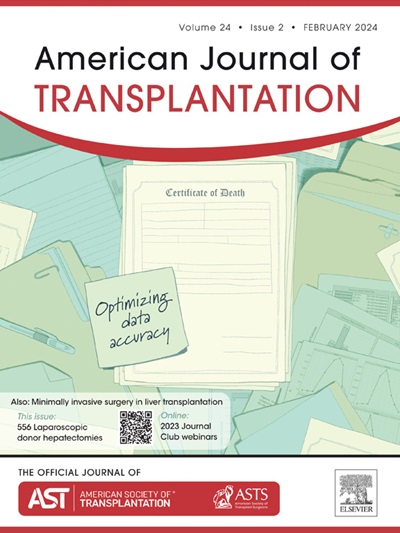猪肺移植冷缺血保存和再灌注过程中的代谢变化。
IF 8.2
2区 医学
Q1 SURGERY
引用次数: 0
摘要
肺移植是治疗终末期肺病患者的基石,但缺血-再灌注损伤(IRI)在移植后恢复中是一个重要的并发症。本研究旨在了解供体类型、冷缺血时间(CIT)和再灌注对移植物肺代谢变化的影响。猪供体肺在冰上进行不同的CIT:最短时间(对照组),6小时(CIT- 6h)和30小时(CIT- 30h)。此外,对脑死亡(BD)动物的肺进行24小时CIT (BD-CIT- 24h)。CIT-30H和BD-CIT-24H肺均行体外肺灌注12小时后左肺移植再灌注2小时。肺组织样本进行代谢组学分析。低温保存诱导某些代谢物随时间变化。在BD-CIT-24H组中,代谢物水平的变化趋势与CIT-30H组相似,但某些代谢物水平明显不同。在CIT-30H肺中,再灌注诱导碳水化合物和氨基酸途径的显著变化,以及能量底物的消耗和抗氧化剂的减少。再灌注后BD供体肺溶血磷脂明显降低。了解肺移植物中的这些代谢变化有助于阐明IRI的机制,为未来开发有针对性的策略以改善供肺保存和临床结果提供有价值的见解。本文章由计算机程序翻译,如有差异,请以英文原文为准。
Metabolic changes during cold ischemic preservation and reperfusion in porcine lung transplants
Lung transplantation is a cornerstone in treating patients with end-stage lung disease, yet ischemia-reperfusion injury poses significant complications in posttransplant recovery. This study aimed to understand the effects of donor type, cold ischemic time (CIT), and reperfusion on metabolic changes in lung grafts. Porcine donor lungs underwent different CITs on ice: minimal time (control), 6 hours (CIT-6H), and 30 hours (CIT-30H). Additionally, lungs recovered from animals after brain death (BD) underwent 24-hour CIT (BD-CIT-24H). Both CIT-30H and BD-CIT-24H lungs underwent ex vivo lung perfusion for 12 hours, followed by left lung transplantation and reperfusion for 2 hours. Lung tissue samples were subjected to metabolomic analysis. Cold preservation induced time-dependent changes of certain metabolites. In the BD-CIT-24H group, while most trends in metabolite levels were similar to those in the CIT-30H group, some were markedly different. In CIT-30H lungs, reperfusion induced significant changes in the carbohydrate and amino acid pathways, along with consumption of energy substrates and reduction in antioxidants. BD donor lungs exhibited significantly reduction in lysophospholipids after reperfusion. Understanding these metabolic changes in the lung grafts shed lights on the mechanism of ischemia-reperfusion injury, offering valuable insights for future development of targeted strategies to improve donor lung preservation and clinical outcome.
求助全文
通过发布文献求助,成功后即可免费获取论文全文。
去求助
来源期刊
CiteScore
18.70
自引率
4.50%
发文量
346
审稿时长
26 days
期刊介绍:
The American Journal of Transplantation is a leading journal in the field of transplantation. It serves as a forum for debate and reassessment, an agent of change, and a major platform for promoting understanding, improving results, and advancing science. Published monthly, it provides an essential resource for researchers and clinicians worldwide.
The journal publishes original articles, case reports, invited reviews, letters to the editor, critical reviews, news features, consensus documents, and guidelines over 12 issues a year. It covers all major subject areas in transplantation, including thoracic (heart, lung), abdominal (kidney, liver, pancreas, islets), tissue and stem cell transplantation, organ and tissue donation and preservation, tissue injury, repair, inflammation, and aging, histocompatibility, drugs and pharmacology, graft survival, and prevention of graft dysfunction and failure. It also explores ethical and social issues in the field.

 求助内容:
求助内容: 应助结果提醒方式:
应助结果提醒方式:


